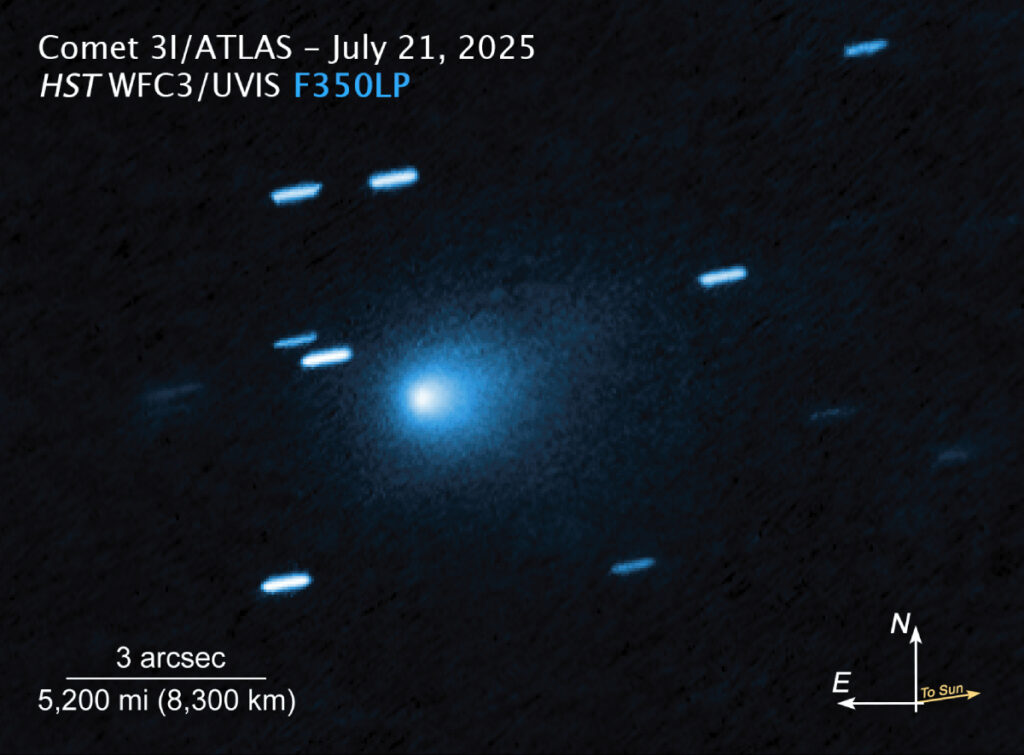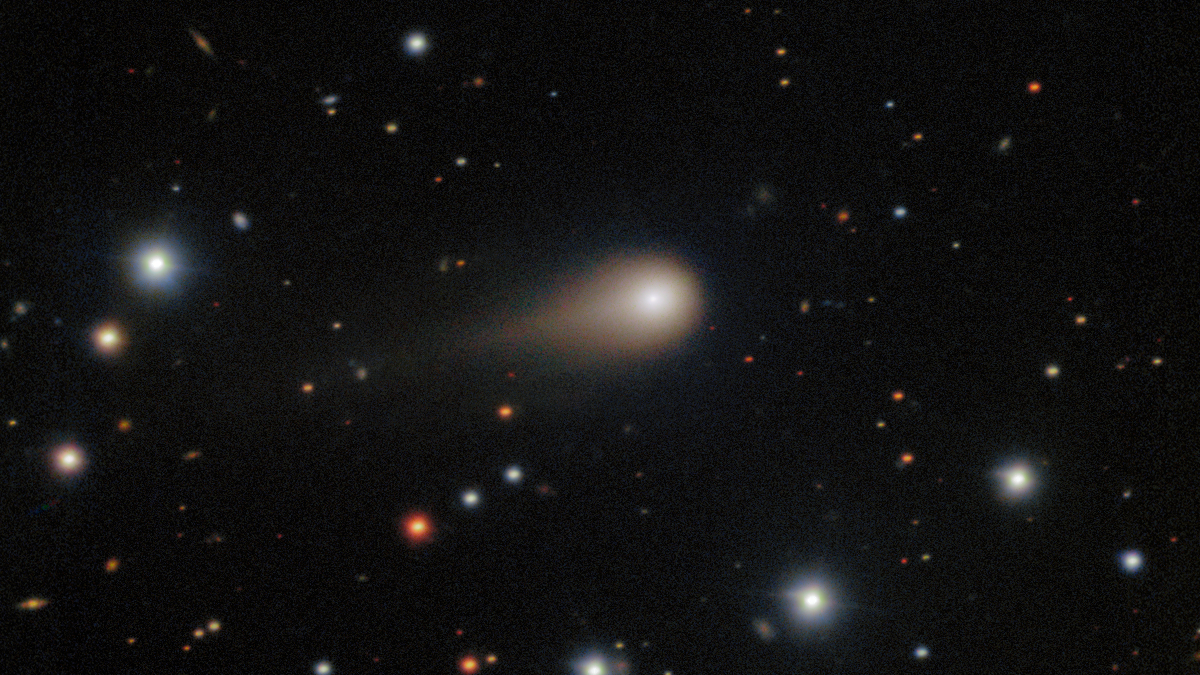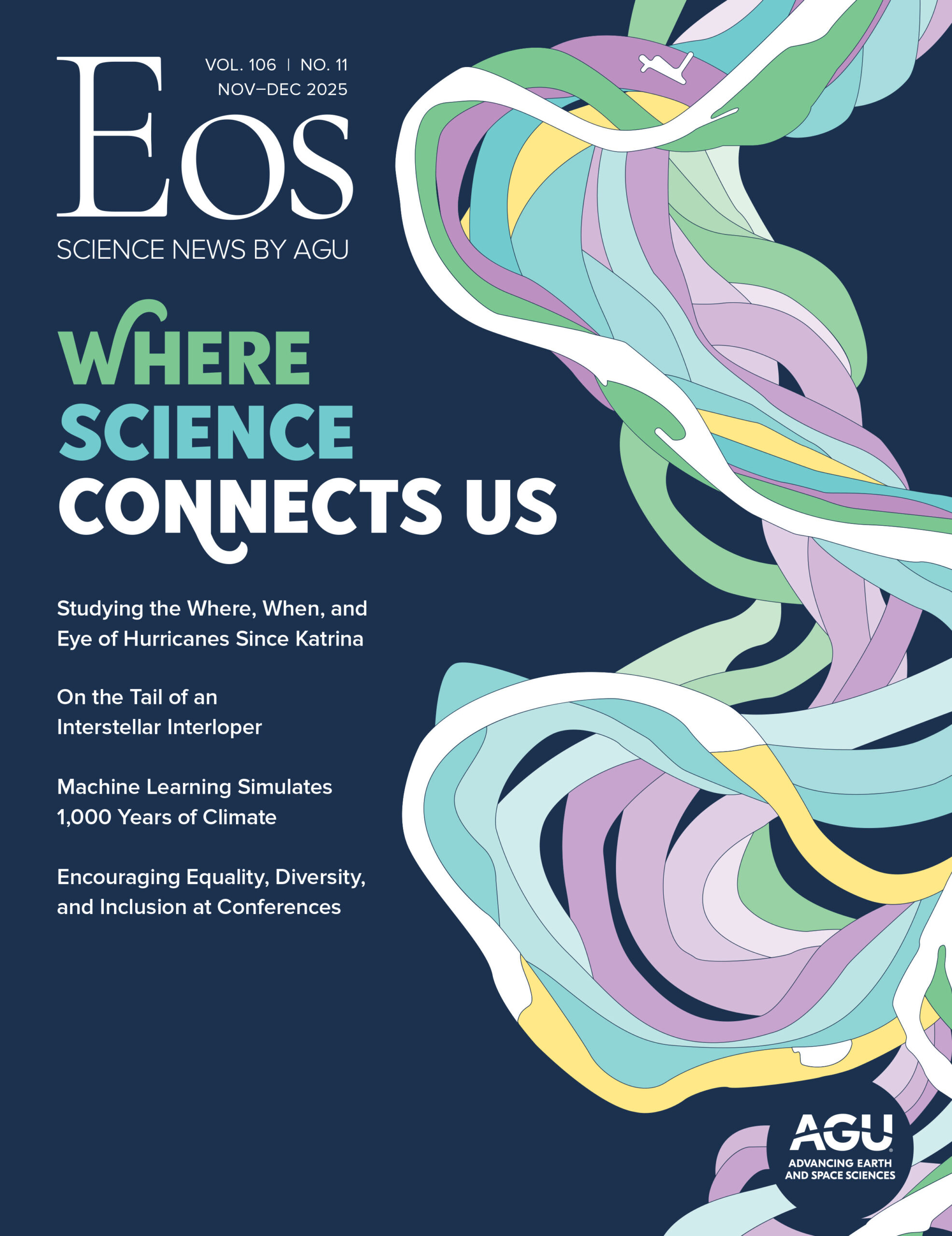On 1 July 2025, astronomers detected a visitor from the deep reaches of space. At the time of discovery, the object was just inside Jupiter’s orbit and was zipping across our solar system 4 times faster than the New Horizons probe sped past Pluto. It was first spotted by the Asteroid Terrestrial-impact Last Alert System (ATLAS) in Chile, which was specifically designed to spot small, fast-moving objects like this. ATLAS sent out a public, automated alert, and when astronomers saw it, they quickly went to work calculating the object’s orbit and trajectory.
That’s when things got interesting. Backtracking the object’s path showed that its origins were not in the Oort cloud, the outermost region of our solar system responsible for most of the comets we see. Instead, the object’s journey started a long time ago in a star system far, far away.
The earliest observations of the object—now labeled 3I/ATLAS for being the third confirmed interstellar object (3I)—showed a distinct coma or haze of material surrounding a dense center.
The trajectory of 3I/ATLAS suggests that it will escape the modest gravitational clutches of the Sun in mid-2026, and that time frame has contributed to a flurry of activity among scientists in the emergent field focused on studying interstellar objects (ISOs). Teams of researchers have secured time on some of the most prominent telescopes around the world and in space, combed through telescope archives for “precovery” images, run computer models and simulations, and released nearly three dozen quick-look research papers in astronomy’s preferred preprint repository.
“We knew we were going to get a 3I. We didn’t know when we were going to get a 3I.”
“We knew we were going to get a 3I. We didn’t know when we were going to get a 3I,” said Michele Bannister, who researches small solar system objects at the University of Canterbury in Ōtautahi-Christchurch, Aotearoa New Zealand.
The speed of discoveries about this interstellar visitor outpaced efforts made when the first and second interstellar objects were discovered: 1I/’Oumuamua in 2017 and 2I/Borisov in 2019. One ISO might be a fluke, and two may be a coincidence, but three seemed inevitable. Astronomers took no chances in preparing for the likely arrival of another interstellar visitor.
Teams’ carefully laid plans have borne fruit, enabling rapid-response science, close international collaborations, and a united global effort to learn as much as possible about 3I/ATLAS before it disappears forever.
Planning for 3I
The arrival of ‘Oumuamua caught astronomers by surprise. It was the first discovery of its kind and wasn’t spotted until it was on its way out of the solar system. Researchers had a mere 2 weeks to get all the data they possibly could, taking their best guesses about what telescopes, instruments, and wavelengths would provide the best data on such short notice.
When something like ‘Oumuamua shows up, “you immediately write what’s called a director’s discretionary [DD] proposal,” explained Karen Meech, a planetary astronomer at the University of Hawai‘i’s Institute for Astronomy. “You scramble, you write a proposal, you submit it. The [telescope] director reads it and makes a decision without a review panel.” Bypassing a review panels speeds up the process but is less democratic.
Having found one ISO, researchers started putting in DD proposals every semester in case another one showed up.
“Astronomers are always trying to use these facilities as efficiently as possible.”
When Borisov appeared 2 years later, it was immediately obvious that it was radically different from ‘Oumuamua. The way observations were allotted on telescopes was also different—facilities became overwhelmed with the sheer volume of DD proposals, Meech said. That led to duplicate observations and some teams’ observations being bumped entirely when a newer, but identical, proposal came in. Telescopes have since worked out those kinks in the system to streamline the DD proposal process.
Anticipating the inevitable detection of a third interstellar object, many ISO observers took a different approach: target of opportunity (TOO) proposals. TOO is a process commonly used in branches of astronomy that study unpredictable phenomena like supernovas, kilonovas, gravitational waves, and gamma ray bursts. Researchers submit observing proposals for short observations of events that could happen at any time. If the event occurs, the team can trigger those telescope observations.
“Most collaborations, including ours, have preapproved dormant programs at the world’s largest telescopes ready to be activated when a suitable [ISO] candidate is confirmed,” said Raúl de la Fuente Marcos, who researches small solar system objects at the Universidad Complutense de Madrid in Spain. Before ‘Oumuamua, “such a discovery was considered highly unlikely. Now all the collaborations that have been involved in early data releases of 3I/ATLAS have such systems.”

“Basically, if you give us more than a semester to plan, we will plan,” Bannister said. “Astronomers are always trying to use these facilities as efficiently as possible.”
De la Fuente Marcos and his team imaged and obtained spectra of 3I/ATLAS with the Gran Telescopio Canarias and the Two-meter Twin Telescope, both in Spain’s Canary Islands. Their observing program was triggered a mere 6 hours after 3I/ATLAS was confirmed as an interstellar object, allowing them to observe the comet from 2 to 5 July. Their results, published in Astronomy and Astrophysics, were the first to show that 3I/ATLAS’s spectrum is red and dusty, not too dissimilar from dusty solar system comets.
Teddy Kareta’s observations were more serendipitous. Kareta, a planetary scientist at Villanova University in Pennsylvania, already had time scheduled on the NASA Infrared Telescope Facility (IRTF) for 3 and 4 July. He learned about 3I/ATLAS the evening before his observing run and thought, “That’s too cool to be real,” he recalled.
“And then I woke up to about seven text messages, three missed calls, a dozen emails, most of which were saying, ‘Hey, I noticed you’re on the telescope because I checked the schedule— You’re gonna go out, right?’” Kareta said.
But the comet was coming in much faster than past ISOs and from a direction that made it challenging to observe.
“It was a very communal planning process, which I think for science often doesn’t happen so quick and on the fly.”
“People were coming up with observational plans on the fly,” Kareta said. “I pointed a 4-meter telescope at it for 2 full hours, and I think I got three useful images.”
There were plenty of emails, group chats, and Zoom calls trying to figure out the best telescope and camera settings.
“It was a very communal planning process, which I think for science often doesn’t happen so quick and on the fly,” Kareta said. “It felt more like a readiness exercise than it did like a traditional kind of planning….You need as many hands on deck as possible to make it work at all.”
Kareta and his colleagues’ infrared spectral observations, accepted for publication in Astrophysical Journal Letters, suggest that the comet may have a complex grain size distribution, grain compositions unlike solar system comets, or both.
A Broad Research Umbrella
By its galaxy-traveling nature, 3I/ATLAS quite literally connects comet science with the study of stars, planetary systems, and the galaxy.
ISO theorists have spent the time since Borisov’s departure working on a computer model that predicts the properties of interstellar objects across the galaxy. They had timed the release of their Ōtautahi-Oxford model for the beginning of science operations of the Vera C. Rubin Observatory and its Legacy Survey of Space and Time (LSST), which is expected to discover dozens of potential interstellar objects.
“We knew that LSST and Rubin were going to find loads, but we just thought this was going to happen in 6 months’ time, not now,” said Matthew Hopkins, who studies both ISOs and galaxy evolution at the University of Oxford in the United Kingdom.
Comet 3I/ATLAS “really did arrive with fantastic timing.”
Luckily, the model team, composed of people studying interstellar objects, comets, stars, and galaxy dynamics, was putting the finishing touches on a program that could analyze an ISO’s speed and orbital information and predict where in the galaxy it may have come from.
Comet 3I/ATLAS “really did arrive with fantastic timing,” Hopkins said.
The team jumped into action when the comet’s orbital characteristics were announced. It was detected when it was 670 million kilometers (420 million miles) away, traveling at nearly 60 kilometers per second and coming in at a steep angle. Bannister, part of Ōtautahi-Oxford’s New Zealand contingent, said that her team was able to share its results so quickly because it had members scattered from western Europe to New Zealand. After working all day, the New Zealanders could hand off the research to European team members, whose day was just starting. By tag teaming the science, they submitted their analysis to Astrophysical Journal Letters about 84 hours after the comet’s discovery. (It has since been published.)

“Especially for 3I, given that it was time sensitive, we definitely wanted to share our results as we had them,” Hopkins said.
The Ōtautahi-Oxford model showed that because 3I/ATLAS entered the solar system at a much steeper angle than either ‘Oumuamua or Borisov, it likely came from a different region of the galaxy, a part known as the thick disk. Though most young and middle-aged stars, including the Sun, live in the narrow thin disk of the Milky Way, many older stars live in the thick disk. The trajectory of 3I/ATLAS suggests that it originated from a star system that could be more than 7.6 billion years old. Indeed, its parent star may already be dead.
The age of 3I/ATLAS has intrigued many researchers who study stellar populations, galaxy dynamics, the birth of exoplanetary systems, and astrobiology, fields that are usually disparate and siloed.
“If you’re studying interstellar objects, you’re sitting cleanly at the division between planetary science and traditional astrophysics.”
“If you’re studying interstellar objects, you’re sitting cleanly at the division between planetary science and traditional astrophysics,” Kareta said. “And I think that means that people from both groups immediately know these are important.”
“Our colleagues who do extragalactic science and supernovae are really excited to help with 3I, and so we’re trying to trigger everything we can on the big telescopes,” Meech said. Her group had been hoping to use the Keck II telescope in Hawaii to obtain high-resolution infrared spectra of the comet, but the telescope had been experiencing technical issues. A student studying kilonovas had TOO time on the nearby James Clerk Maxwell Telescope and donated it.
“He said, ‘You know what, [the kilonova is] not going to go off in the next 2 weeks. Let’s use it for this,” Meech recalled. “And so we got five nights of observations on this object.” Meech and her colleagues are still analyzing those data to understand the abundances of certain gases in 3I/ATLAS’s coma.
The Long-Term Strategy
Several weeks after its initial discovery, it is clear that 3I/ATLAS looks and behaves like a comet. It’s now millions of kilometers closer to the Sun than it was upon detection in early July, and more recent observations, including from the Hubble Space Telescope, James Webb Space Telescope, Very Large Telescope, and more, have shown a dusty coma emitted from the Sun-facing side and the beginnings of a traditional comet tail behind it.
Most of the earliest 3I/ATLAS papers are still undergoing peer review, and Kareta said that more research analyzing July observations will continue to trickle out. Too, groups that wrote early papers will be going back over their data to put them in context with newer information and provide deeper analyses of those initial quick looks.

However, with the early rush of observations mostly completed, some scientists are turning their attention to what they want to learn about 3I/ATLAS in the coming months.
“A lot of teams are still scrambling to get telescope time,” Meech said.
The comet will reach its closest approach to the Sun, a mere 35% farther than the Earth-Sun distance, on 29 October. Earth will lose sight of it in the Sun’s glare in early September, but by mid-August, 3I/ATLAS had already started outgassing, as predicted. Astronomers were eager to analyze the chemistry of the gases it emitted because that could give clues about its history.
“Stellar encounters this close are actually really rare for interstellar objects,” Hopkins said. This is probably 3I/ATLAS’s first encounter with a star since it was booted out of its own system, and its surface material has likely been frozen in time since then. “We can use that to learn some really cool things about the chemistry of its parent star halfway around the galaxy, even if it’s dead.”
Spectra obtained from 3I/ATLAS’s coma in mid-August showed strong signs of water ice, carbon dioxide, nickel, and cyanide—all expected of a comet emitting a mixture of gas and dust as it heats up. “Typically for comets, the first thing you see is CN, cyanide, not because it’s particularly abundant but because it interacts so strongly with sunlight,” Meech said.
“There’ll be a lot of happy arguments around ‘Where did this form in the disk of its home star, and what does that tell us about the conditions that were like in that protoplanetary disk.’”
Indeed, scientists are seeing an object not too unlike a domestic comet, and they’ll continue to monitor its outgassing as it gets closer to the Sun.
The outgassing of carbon monoxide would be particularly telling, as the compound freezes solid only in extremely cold conditions like those that exist in the outer reaches of a star system. So if 3I/ATLAS outgasses carbon monoxide, Hopkins explained, it would be a strong hint that the object may have formed in the coldest outer regions of its system’s protoplanetary disk.
“There’ll be a lot of happy arguments around ‘Where did this form in the disk of its home star, and what does that tell us about the conditions that were like in that protoplanetary disk,’” Bannister added.
Still, who knows? “These are representative fragments of star formation elsewhere. There’s no reason that every protoplanetary disk has the same chemical distribution,” Meech said.
Every snapshot researchers get from now until 3I/ATLAS’s departure will help them put together a holistic, time series picture of the comet as it heats up and evolves. No one even knows whether it will survive its closest approach to the Sun in October.
All eyes, and telescopes, will be trained on its predicted point of emergence in late November.
Time Enough for Everyone
The biggest advantage that scientists have with 3I/ATLAS that they did not have with 1I/’Oumuamua is time—time not only to make more observations and analyses but to enable the widest participation possible.
‘Oumuamua arrived in October, the middle of the academic semester. Scientists who could respond quickly tended to be senior-level researchers, those with fewer teaching responsibilities, and those at institutions with easier access to telescope facilities, Kareta explained. Early-career scientists, those involved with research programs, or those who had inflexible responsibilities were less able to contribute to the groundbreaking discovery in the two-ish weeks before the object disappeared.
“The longer we have to study it, that means more people can work on it, more brains can take a crack at the problem and…leave their mark on this object.”
With 2I/Borisov and now with 3I/ATLAS, a monthslong observation window has enabled a larger, more diverse group of scientists from around the world to participate in observing, analyzing, and discussing this discovery.
“The longer we have to study it, that means more people can work on it, more brains can take a crack at the problem and…leave their mark on this object,” Kareta said.
And that can be only a positive thing for this nascent, but growing, field of science.
“We’re 7 years into this field of small-body galactic studies,” Bannister said. “There’s a whole different generation of people coming into this than were involved in 1I and even 2I. That’s really exciting to see.”
—Kimberly M. S. Cartier (@astrokimcartier.bsky.social), Staff Writer


